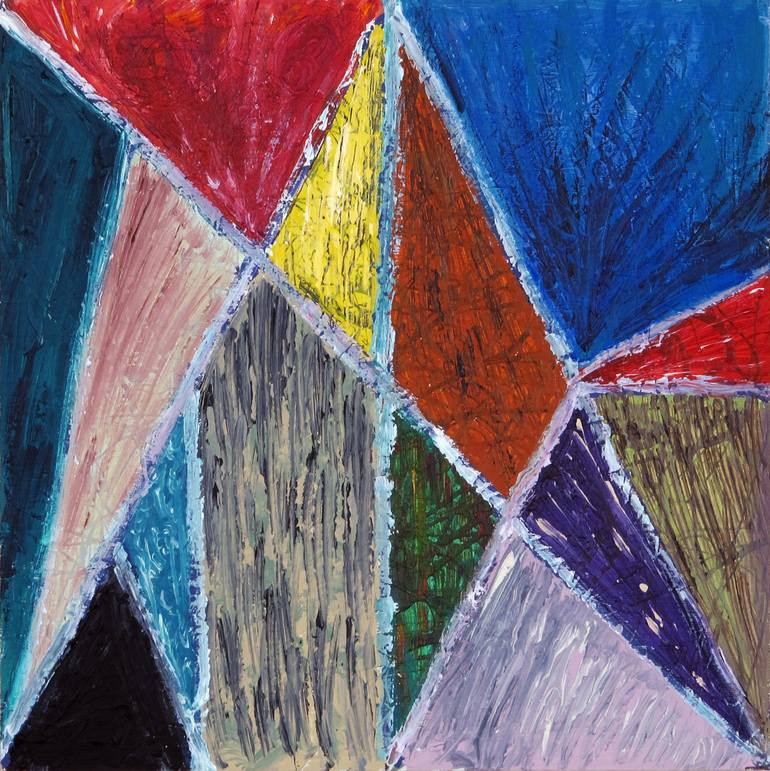


VIEW IN MY ROOM
Stomachion Painting
United States
Painting, Acrylic on Wood
Size: 24 W x 24 H x 0.3 D in
About The Artwork
Before Archimedes ran naked through the streets of ancient Syracuse screaming "Eureka!", he contemplated the combinatorics of the stomachion, an ancient tangram puzzle whose Greek name means "belly-ache" because of its difficulty: How many ways can the differently-colored internal shapes (as shown here) be rearranged to form another perfect square? It took 2,250 years before a modern mathematician solved this problem using computers (and the answer is 536), but recently (1999) it was discovered that Archimedes had attempted it far earlier than anyone had imagined. That attempt constituted the earliest exploration of combinatorics (albeit, sans a solution to the stomachion), and had been preserved in a palimpsest (a medieval form of book recycling) in which the original text had been all but scraped away for reuse as a Christian hymnal that was kept in a monastery in Syria for hundreds of years. We therefore know that combinatorics had been explored by Archimedes during Alexandrian times, some 1500 years earlier than when Europeans were first thought to have explored the subject in the Middle Ages. Thus, it's now fair game to use this puzzle for more prosaic purposes, such as done here by the artist. Using the "canonical" arrangement of the internal figures, the artist applied contrasting colors in a paint-by-numbers fashion, highlighting some of them with whites (and off-whites) that suggest the ejaculation of farm animals who couldn't give a shit about mathematics and would rather eat slop and fuck each other when not licking the afterbirth off their progeny. (c) 2012 Thomas M. Brodhead
Details & Dimensions
Painting:Acrylic on Wood
Original:One-of-a-kind Artwork
Size:24 W x 24 H x 0.3 D in
Frame:Not Framed
Ready to Hang:No
Shipping & Returns
Delivery Time:Typically 5-7 business days for domestic shipments, 10-14 business days for international shipments.
Have additional questions?
Please visit our help section or contact us.
United States
A native of St. Louis who’s lived in middle Tennessee most of his life, Thomas Brodhead studied classical music theory, history, and composition at Oberlin in the 1980s. During those years, he pored over classical scores while studying orchestral and chamber works, unaware that he was absorbing geometric graphic design that’s been in his blood ever since. After college, he worked as a classical sheet music editor and engraver (music typesetter) for 20 years, writing original computer programs to set music notation so that it conformed to the best Greek proportions and geometries. (Importantly, he produced a Critical Performing Edition of the Fourth Symphony of Charles Ives, a work so rhythmically complex that it requires at least two—if not three—conductors to perform.) But arranging black glyphs on white paper grew tiresome, and starting in 2009, he turned to color and began to paint. At first, his paintings were cartoonish and comical, always paired with tongue-in-cheek artist statements on the meaning of each piece. Over time, though, he began to take his work more seriously, exploring color and geometry on large canvases (up to 4 feet by 3 feet), but never failing to pen an accompanying whimsical statement. But more and more the whimsy veiled serious social commentary, often on the dangers of transhumanism (the integration of humans and technology) and the infantilizing effects of social media. Painting and writing thus combined in a Wagnerian Gesamtkunswerk, in which the combination of the two formed the total artwork. He joked that his early humorous style—cartoonish and splattery, with an emphasis on narrative—was “on an overlooked axis connecting Jackson Pollock and Norman Rockwell.” But after studying the color theory of Albert Munsell and discovering the joyous geometries of the artist Stuart Davis, his work took a sharp turn. Still working on larger canvases, he began planning each work in detail, defining the exact composition of its figures and determining its color scheme in advance. The execution of the paintings took longer and longer, one even clocking in at 160 hours. Borrowing a technique from 20th century classical music—and a technique perhaps never before applied to visual art—he produced a series of fractalized paintings that, at times, have a dizzying paint-by-numbers quality.
Thousands Of Five-Star Reviews
We deliver world-class customer service to all of our art buyers.
Global Selection
Explore an unparalleled artwork selection by artists from around the world.
Satisfaction Guaranteed
Our 14-day satisfaction guarantee allows you to buy with confidence.
Support An Artist With Every Purchase
We pay our artists more on every sale than other galleries.
Need More Help?